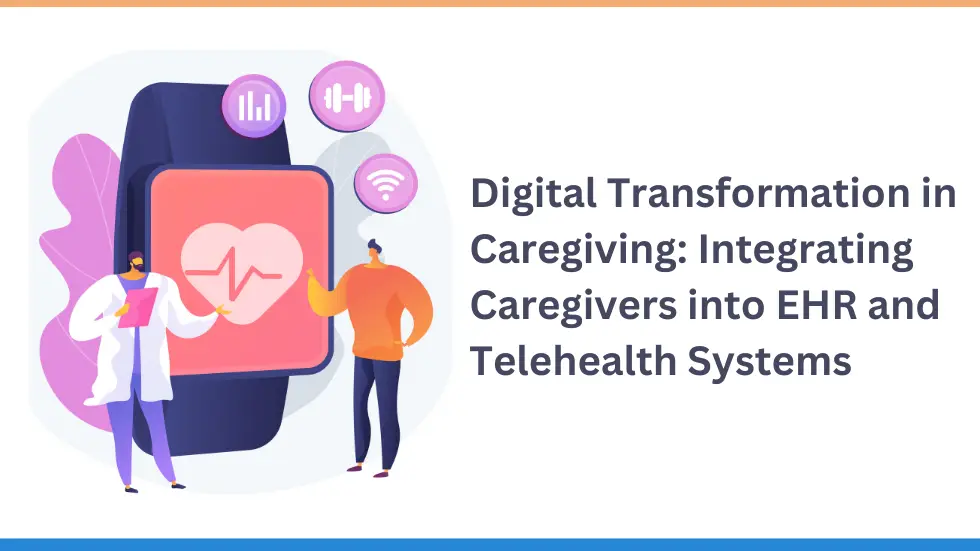The healthcare industry is undergoing a Digital Transformation in Caregiving, driven by the adoption of Electronic Health Records (EHRs) and the rapid expansion of Telehealth.
While these technologies promise increased efficiency and improved patient outcomes, their true potential relies on engaging all key participants in the care continuum—most importantly, caregivers.
Caregivers—whether family members, friends, or professional aides—play a pivotal role in patient care. Recognizing their contributions and integrating them into digital healthcare systems is central to achieving patient-centered care and enhancing the overall healthcare experience.
This blog explores how caregivers are becoming integral to the digital healthcare ecosystem, the opportunities this creates, and the challenges to consider when implementing caregiver-focused digital solutions.
The Evolving Role of Caregivers in Digital Healthcare
Traditionally, caregivers operated outside the digital healthcare framework. Their critical insights—daily care routines, observations, and advocacy—often remained undocumented in EHRs and unrecognized in telehealth consultations.
However, the Digital Transformation in Caregiving emphasizes empowering caregivers to become active participants. Benefits include:
- Comprehensive Patient Insights: Caregivers provide detailed observations on daily functioning, symptom changes, and adherence to care plans—information that might otherwise go unnoticed.
- Enhanced Communication and Coordination: EHRs and telehealth platforms facilitate seamless communication between caregivers and healthcare providers.
- Improved Patient Safety: Timely caregiver input can help detect early signs of complications, allowing proactive interventions.
- Increased Patient Engagement and Adherence: Caregivers support patients in following care plans and maintaining treatment adherence.
- Reduced Caregiver Burden: Access to digital tools, resources, and support networks can alleviate stress and feelings of isolation.
Pathways for Caregiver Integration in Digital Healthcare
1. EHR Portals with Caregiver Access
Modern EHR platforms now allow patients to grant caregivers controlled access to their health records, enabling:
- Monitoring Medical History: Diagnoses, medications, lab results, and treatment history.
- Reviewing Care Plans: Ensuring consistent adherence to prescribed treatments.
- Direct Communication with Providers: Secure messaging channels for updates and clarifications.
- Scheduling and Administrative Support: Appointment management and prescription requests.
- Documenting Observations: Structured input on daily patient activities, symptoms, and treatment adherence.
Example: Sarah, caring for her mother with diabetes and early-stage Alzheimer’s, uses the EHR portal to track medications, appointments, and communicate with her mother’s physician, improving care coordination.
2. Telehealth Platforms with Caregiver Participation
Telehealth is evolving to actively include caregivers through:
- Three-Way Video Consultations: Caregivers join virtual visits to provide context and ask questions.
- Dedicated Caregiver Telehealth Sessions: Focused on training, guidance, and emotional support.
- Remote Monitoring Alerts: Caregivers receive notifications about vital signs or potential issues.
- Virtual Education Tools: Telehealth-based training empowers caregivers with critical skills.
Example: John participates in telehealth sessions with his father recovering from a stroke, receiving guidance from the therapist and supporting rehabilitation at home.
3. Mobile Health (mHealth) Applications for Caregiver Support
mHealth apps are designed to empower caregivers with tools for efficient care management:
- Medication Tracking Apps: Reminders for medication administration and adherence tracking.
- Symptom Logging Apps: Record symptoms and share securely with healthcare providers.
- Collaboration Platforms: Enable communication between caregivers and care teams.
- Educational Resources and Support Networks: Provide knowledge, training, and peer support.
Example: Maria uses a mobile app to manage her husband’s heart failure medications, track adherence, and communicate securely with his cardiologist.
Challenges in Implementing Digital Caregiver Integration
While integrating caregivers into EHRs and telehealth offers significant benefits, challenges include:
- Privacy and Security: Protecting sensitive patient data while granting appropriate caregiver access.
- Technological Literacy: Ensuring platforms are user-friendly for caregivers with varying tech skills.
- Defining Access Levels: Balancing caregiver authority with patient autonomy.
- Workflow Integration: Training providers to incorporate caregiver input effectively.
- Preventing Caregiver Burnout: Digital tools should reduce, not increase, caregiver stress.
- Ethical Considerations: Access must always align with patient consent and best interests.
The Future of Digital Transformation in Caregiving
The Digital Transformation in Caregiving is shaping a collaborative and patient-centered healthcare ecosystem. Emerging trends include:
- AI-driven Insights: Analyzing caregiver inputs to identify risks or patterns.
- Personalized Interfaces: Simplified and intuitive digital tools for caregivers.
- Interoperable mHealth Apps: Seamless integration with EHR systems.
- Holistic Patient Profiles: Incorporating social determinants and caregiver-provided context.
- VR and AR Training Tools: Innovative methods for caregiver education and support.
By embracing these strategies, healthcare systems can leverage caregiver expertise, enhance patient outcomes, and create a more supportive and effective care ecosystem.
Caregivers are no longer peripheral—they are vital participants in the future of healthcare, empowered by digital tools.
Additional Resources:
